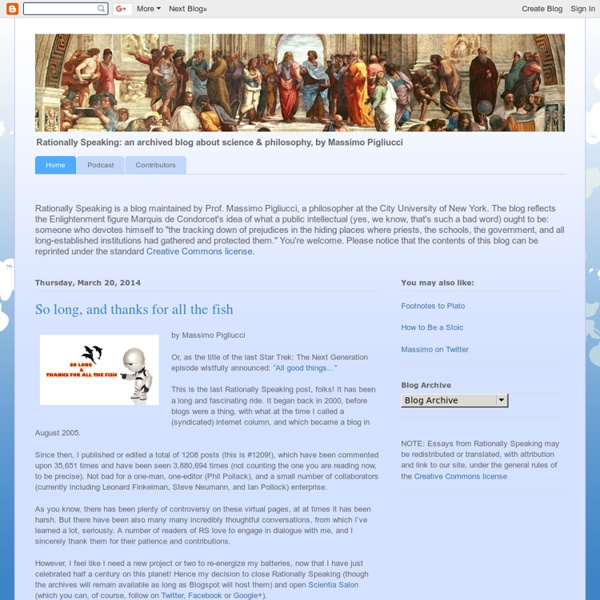



NeuroLogica Blog Jul 14 2015 Why Pluto is Important As I write this post we are just minutes away from the closest approach of the New Horizons probe to Pluto, the farthest world we have thus far explored (24 minutes and counting). It’s an exciting moment, not just for astronomy buffs or science enthusiasts, but for humanity. I’m glad to see an appropriate level of excitement among the media and the general public. Still, a couple of people have commented to me or in my presence that they don’t understand what the big deal is or why this is important, so allow me a moment to explore why I think this is such a big deal. First, let us not forget what it took to get there. Continue Reading » Jul 13 2015 Supporting the Narrative in an Echochamber Dunning, commenting on the implications of the Dunning-Kruger effect, wrote: This seems accurate, but I think the situation is actually worse. This more active process has been called the “echochamber effect.” Continue Reading » Jul 09 2015 New Zealand Ban on “Trolling”
The Christopher Hitchens Web WhitePagesGoesGreen.org by YellowPagesGoesGreen.org (Yellow Pages Directory Inc.) is a leading online directory allowing users to search an online database and telephone directory for all telephone numbers in the USA. Using the above boxes, simply type in a name and location. Even if you don't have the complete information, the telephone number lookup database can help you find phone numbers. Using WhitePagesGoesGreen.org, you'll be on your way to finding residential phone numbers and connect with the person you're looking for. YP Announces Changes To White Pages Directory Delivery In Alabama GREATER CALHOUN COUNTY, Ala., March 17, 2014 /PRNewswire/ -- The residential white pages listings provided by AT&T have been removed from future YP Real Yellow Pages SM and YP Rea...
À propos de la brève « Deux façons de servir la science » Dans notre numéro 299 (janvier 2012), Suzy Collin-Zahn commentait, dans la rubrique « Regards sur la science », le livre de Christian Magnan intitulé Le théorème du Jardin. Christian Magnan a souhaité réagir à cette analyse. Vous trouverez sa lettre ci-après ainsi que la réponse de Suzy Collin-Zahn. La réaction de Christian Magnan J’ai été choqué par l’article de Suzy Collin-Zahn paru dans le numéro de janvier 2012 de Science et pseudo-sciences (page 9). Pour illustrer la bonne façon, à ses yeux, de servir la science, notre astrophysicienne choisit la dernière découverte-phare de la physique, à savoir la mise en évidence de neutrinos dont la vitesse dépasserait celle de la lumière : un comportement interdit par la relativité restreinte. C’est précisément cette proposition que conteste mon livre. Les cosmologistes connaissent bien cette façon vicieuse de produire des explications arbitraires face à des observations. Le débat sur les dérives de la science sera-t-il ouvert loyalement ? C.
Home Eric Kaufmann Qu’est-ce que le matérialisme scientifique ? par Jean Bricmont Publié auparavant dans « Intrusions spiritualistes et impostures intellectuelles en sciences », sous la direction de J. Dubessy et G. Lecointre, Syllepse, Paris, 2001, et sur le site Dogma. En général, les dogmes matérialistes n’ont pas été édifiés par des gens qui aimaient les dogmes, mais par des gens qui pensaient que rien de moins net ne leur permettrait de combattre les dogmes qu’ils n’aimaient pas. Ils étaient dans la situation de gens qui lèvent des armées pour défendre la paix.1 Bertrand Russell 1. Lorsque La Raison a rendu compte de notre livre en disant que Sokal et Bricmont défendaient le matérialisme scientifique2, j’étais à la fois surpris, content et perplexe. 2. Pour aller plus loin, observons d’abord que le matérialisme moderne s’est développé en grande partie en réaction aux dogmes religieux. Malheureusement, la réaction scientifique-matérialiste prend souvent le contre-pied des deux thèses à la fois : 1’. 3. 4. 3 Ainsi que moi-même, évidemment.
Science-Based Medicine NeuroTribes "The Structure of Flame" by autistic artist Jessica Park. Courtesy of Pure Vision Arts: In 2007, the United Nations passed a resolution declaring April 2 World Autism Awareness Day — an annual opportunity for fundraising organizations to bring public attention to a condition considered rare just a decade ago. Now society is coming to understand that the broad spectrum of autism — as it’s currently defined, which will change next year with the publication of the DSM-5 – isn’t rare after all. In fact, “autism is common,” said Thomas Frieden, Director of the U.S. Centers for Disease Control and Prevention, last week in a press conference. The CDC’s announcement brought out the usual range of conflicting responses and disputes about causes and cures. No matter where you stand on the rising numbers, there is one undeniably shocking thing about them. Vigil for George Hodgins, Sunnyvale CA For autistic activists like Gross and Paula C. Lydia Brown 1. 2. 3. 4. 5. 1. 2.
La démarche scientifique face à la parapsychologie - Méthode et prudence scientifiques 1. Introduction Ce texte a été rédigé particulièrement pour ceux qui luttent contre les pseudo-sciences, mais aussi à destination des parapsychologues, médiums, partisans de l’ésotérisme etc., pour montrer la différence de point de vue entre celui des scientifiques et le leur. J’ai voulu répondre à leur attente, en apportant un point de vue plus « scientifique » que celui habituel adopté par les tenants des thèses parapsychologiques ou ésotériques, car il m’a semblé intéressant de confronter le point de vue des scientifiques avec celui des médiums, tenants de l’ésotérisme et des parapsychologues. Mais avant de pouvoir le faire, il est nécessaire de procéder à un rappel de la démarche scientifique. 2. La démarche scientifique part d’un certain nombre de présupposés, issus de l’expérience, que nous allons exposer. Voici ces principaux présupposés. 2.1. Tous les phénomènes de la nature procèdent par une série de causes et d’effets déterministes. 2.2. 2.3. 2.4. 2.5. 2.6. 2.7. 3. 4. 4.1. 4.2.
Skepticblog